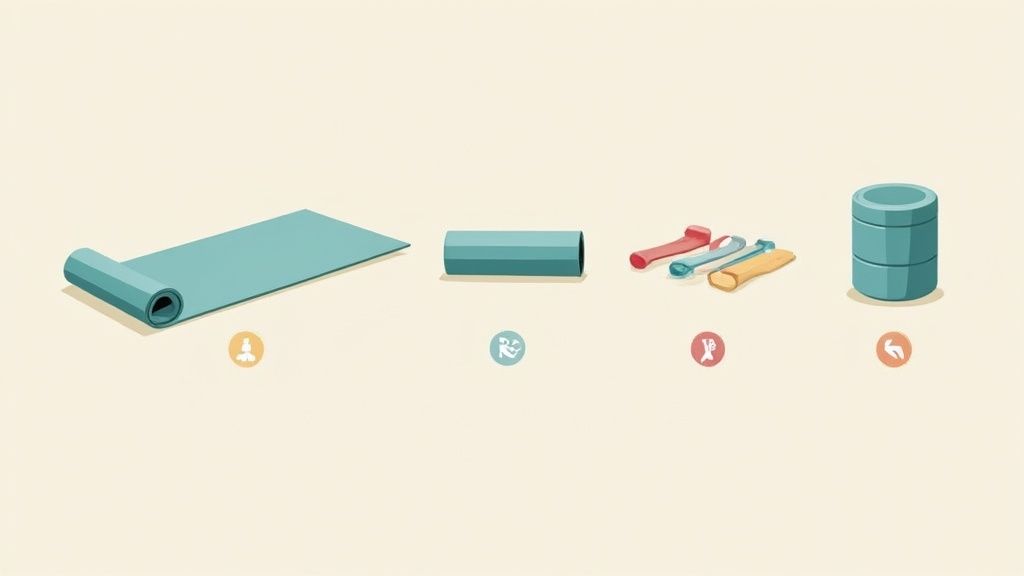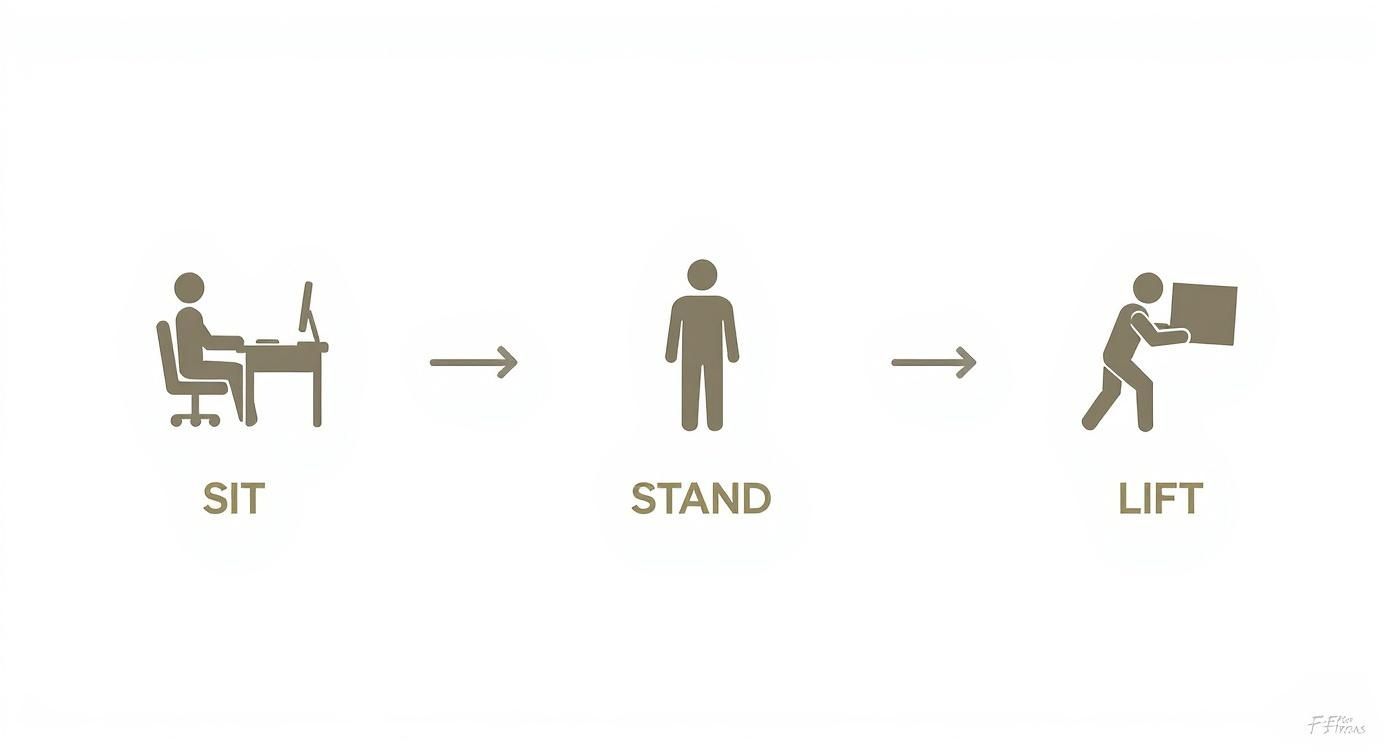Let's be honest, that nagging ache you feel after a long day at the office or a weekend spent doing yard work isn't something you should just accept as normal. The reality is, nearly 20% of people deal with back pain directly linked to their job, but you absolutely have the power to get ahead of it.
Preventing back pain isn't about grueling gym sessions or complicated routines. It's about building smarter, consistent habits that support your spine day in and day out. Think of it as creating a strong foundation from the inside out.
At Bare Fitness, we believe your body is your best tool. You don’t need a gym membership to build a resilient back. This guide is all about showing you how to prevent back pain by focusing on three simple, yet powerful, areas:
- Smarter Posture: Align your body to take unnecessary strain off your back.
- Core Strength: Activate deep muscles that protect and stabilize your spine.
- Ergonomic Tweaks: Small changes to your workspace and home that make a massive difference.
Consistency is the real secret. Small, conscious posture and movement adjustments throughout the day beat one intense workout once a week every time.
Quick Summary / Overview
In this guide, you’ll learn:
- Why posture matters and how to nail it sitting or standing
- Minimal equipment routines for core strength that help prevent back pain
- Smart daily habits—hydration, sleep positions, micro-breaks—to protect your spine
- Common mistakes to avoid and how to track your progress
- Clear next steps and related workout suggestions to keep you moving
Your Back Pain Prevention Cheat Sheet
Keep these four pillars in mind as we explore practical ways to integrate them into your life. Building a stronger, pain-free back is simpler than you think.
What You'll Need for a Stronger Back

Good news: you don't need a decked-out home gym to learn how to prevent back pain. A few well-chosen pieces of gear are all it takes:
- Exercise Mat: Stable, non-slip surface protects your joints and spine alignment.
- Lumbar Support Cushion: Supports the natural curve of your lower back during long hours of sitting.
- Resistance Bands: Gentle challenge to wake up deep stabilizers around your spine and hips.
And don’t forget your mattress—it’s one of your most important tools for spinal health. Explore finding the best mattress for back pain to keep your discs happy while you sleep.
Your Posture: The Foundation of a Healthy Back
Preventing back pain starts with how you hold your body every second of the day. It’s not about forcing a rigid pose; it’s finding a neutral alignment your body can sustain without strain.
Nailing Your Seated Posture
Most of us spend a huge chunk of life sitting, so let’s make every seat count:
- Monitor Height: Top edge at or just below eye level stops the forward head-tuck.
- Keyboard & Mouse: Close enough for a 90-degree elbow bend. Reaching rounds your shoulders forward.
- Feet & Knees: Keep feet flat, knees at 90°, level with or slightly below hips. Prop them if they’re dangling.
Mastering Your Stance
Check your standing posture anywhere—grocery line or kitchen:
- Feet: Shoulder-width, weight evenly distributed, knees soft.
- Hips: Neutral pelvis, not tilted forward or backward.
- Shoulders: Roll up to ears, back, then let drop—opens your chest.
- Head: Imagine a string pulling the top of your head straight up.
Habit is key. Set an alarm or use natural breaks—like refilling your water—to run through this checklist.
Essential Core Exercises for Back Support
A strong, stable core is your spine’s best friend. We’re going beyond endless crunches to functional moves that support how you move every day.

Getting Started: What You’ll Need
- Exercise Mat for comfort and stability.
1. Bird-Dog
- Hands under shoulders, knees under hips.
- Pull your belly button up—keep your back flat.
- Extend right arm forward, left leg back. Hold, then switch.
- Cue: Imagine balancing a glass of water on your lower back.
2. Glute Bridge
- Lie on back, knees bent, feet hip-width.
- Squeeze glutes, lift hips until body forms a line from shoulders to knees.
- Hold 1–2 seconds, lower slowly.
- Cue: Feel it in your glutes, not arching your lower back.
3. Dead Bug
- Lie on back, arms toward ceiling, knees over hips at 90°.
- Press lower back into mat.
- Lower right arm and left leg simultaneously—no arching.
- Return and repeat opposite side.
According to the American College of Sports Medicine, 150 minutes of moderate activity per week can reduce chronic low back pain risk by up to 30%.
Smart Daily Habits to Protect Your Spine

Your back’s health is shaped by the 23+ hours outside your workout:
Master Your Movements
Use the hip hinge for bending or lifting:
- Back neutral, hinge at hips.
- Push hips back like closing a car door with your rear.
- Power with core and glutes, not lower back.
The Power of Micro-Breaks
Set a timer every 30–45 minutes. When it dings:
- Stand, reach overhead, side bend, or walk.
- These tiny interruptions are powerful defenses against cumulative strain.
Your Hidden Allies: Hydration & Sleep
- Drink water steadily—spinal discs are mostly water.
- Back: Pillow under knees to maintain lumbar curve.
- Side: Pillow between knees to align hips and spine.
Common Mistakes to Avoid
Preventing back pain means avoiding habits that undermine your efforts. Steer clear of these pitfalls:
- Rounding your spine while lifting—always hinge at the hips.
- Arching too much in glute bridges—stop when your body forms a straight line.
- Holding your breath during exertion—breathe steadily to maintain core stability.
- Skipping progressive overload—without gradual increases, your muscles won’t adapt.
- Ignoring pain signals—sharp pain is a warning, not a badge of honor.
How to Modify and Progress Your Routine
Your routine should fit you. Listen to your body and adjust:
Making It Easier
- Range of Motion: Shorten movements (e.g., smaller bird-dog extensions).
- Extra Support: Knee planks instead of full planks.
- Shorter Holds: 1-second squeezes instead of 2–3 seconds.
Modification builds your foundation safely, so you can keep progressing.
Leveling Up Safely
Introduce resistance bands or longer holds once your form is solid.
Core Exercise Progressions for Every Level
Next Steps: Keep Moving and Track Your Progress
You’ve learned how to prevent back pain with smart posture, functional core work, and daily habits. Now, keep the momentum going:
- Track Your Wins: Use a journal or app to log posture checks, workout sets, and how you feel—celebrate small victories!
- Progress Tests: Learn to master core muscle strength tests for objective feedback.
- Try These Plans: Ready for more? Discover our equipment-minimal workout plans and start your journey today!
- Related Workouts: Check out our 4-Week Core Challenge or Home Posture Reset program for structured guidance.
Stick with these action steps, and you’ll continue building a stronger, more resilient back—no fancy gym required. You’ve got this!



















